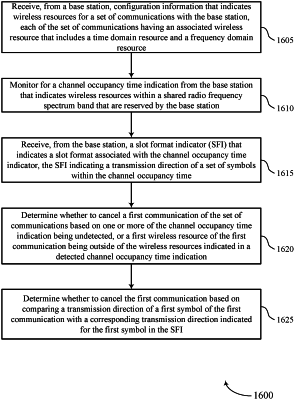| CPC H04W 72/044 (2013.01) [H04W 72/23 (2023.01); H04W 72/51 (2023.01); H04W 74/02 (2013.01)] | 20 Claims |

|
1. A method for wireless communication at a user equipment (UE), comprising:
receiving configuration information that indicates wireless resources for a plurality of communications with a base station, each of the plurality of communications having an associated wireless resource that includes a time domain resource and a frequency domain resource;
monitoring for a channel occupancy time indication from the base station that indicates wireless resources within a shared radio frequency spectrum band that are reserved by the base station;
determining whether to cancel a first communication of the plurality of communications based at least in part on one or more of the channel occupancy time indication being undetected, or a first wireless resource of the first communication being outside of the wireless resources indicated in a detected channel occupancy time indication; and
canceling the first communication when the channel occupancy time indication is undetected or when the first wireless resource is outside of the wireless resources indicated in the detected channel occupancy time indication, wherein:
the configuration information includes a common validation indication that both uplink and downlink communications are to be canceled when the channel occupancy time indication is undetected, or
the configuration information includes an uplink validation indication that indicates whether uplink communications are to be canceled when the channel occupancy time indication is undetected, and a downlink validation indication that indicates whether downlink communications are to be canceled when the channel occupancy time indication is undetected.
|